General Sir John Monash, Personal Files Book 18, 21 April - 8 May 1918, Part 4
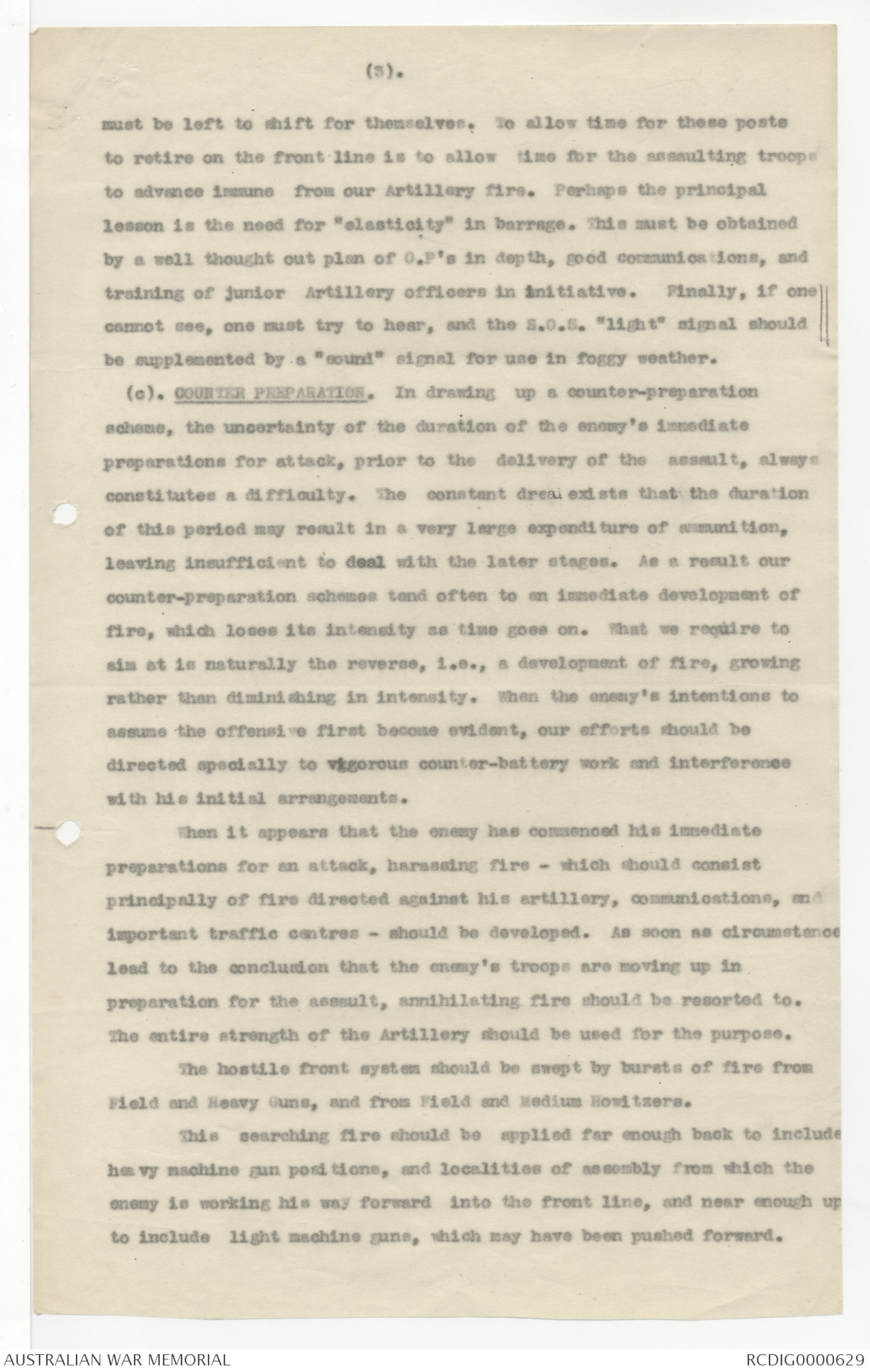
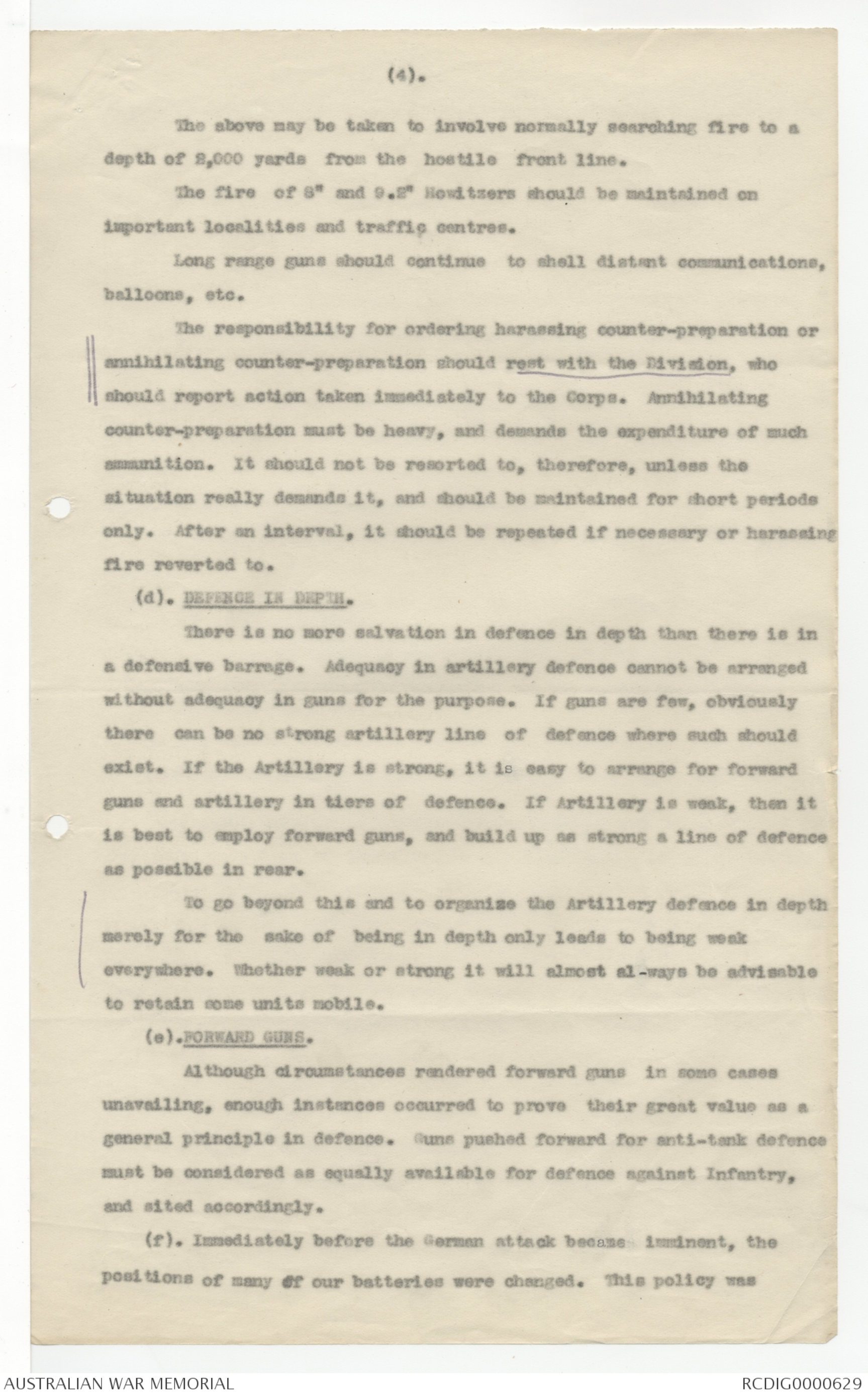
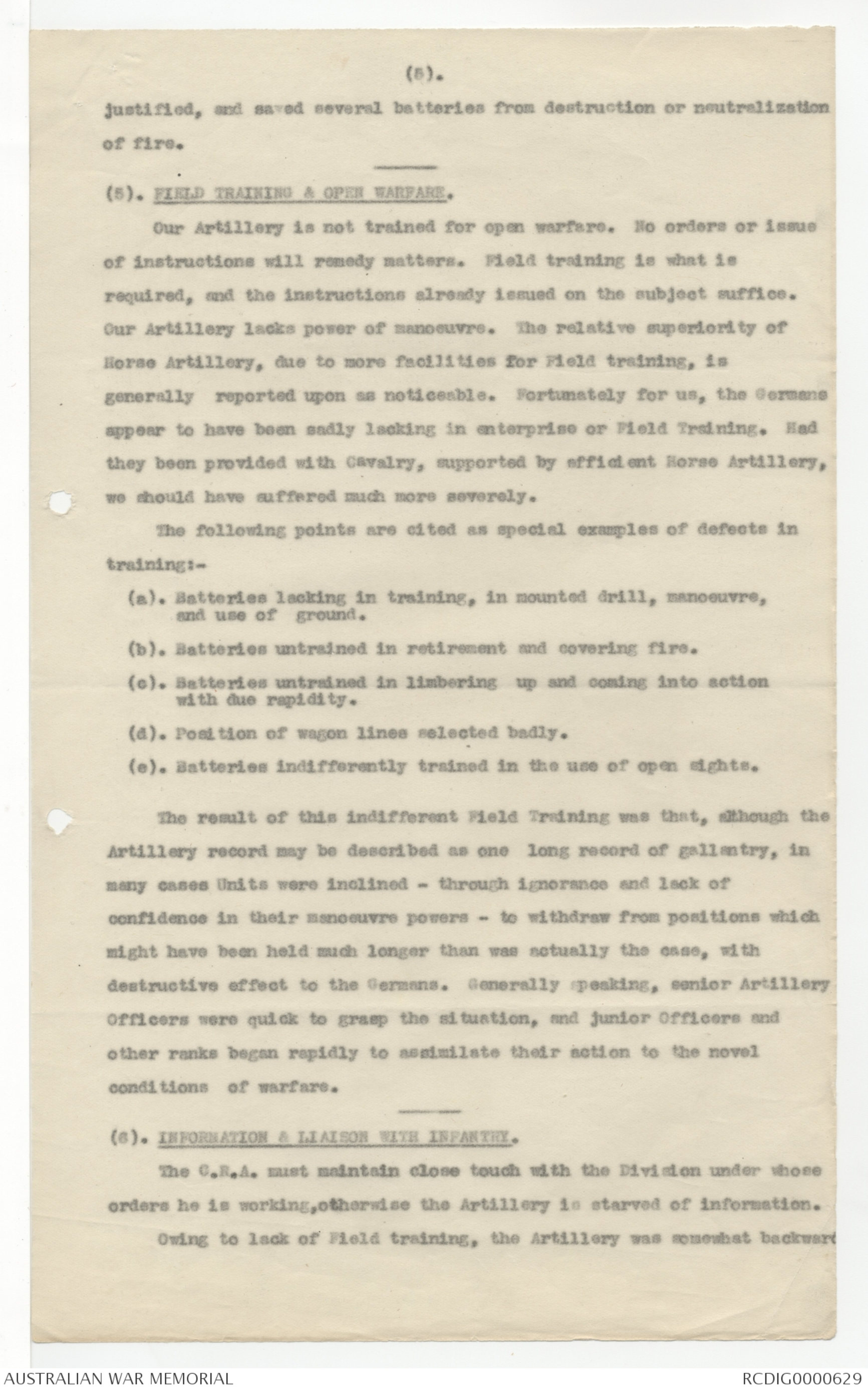
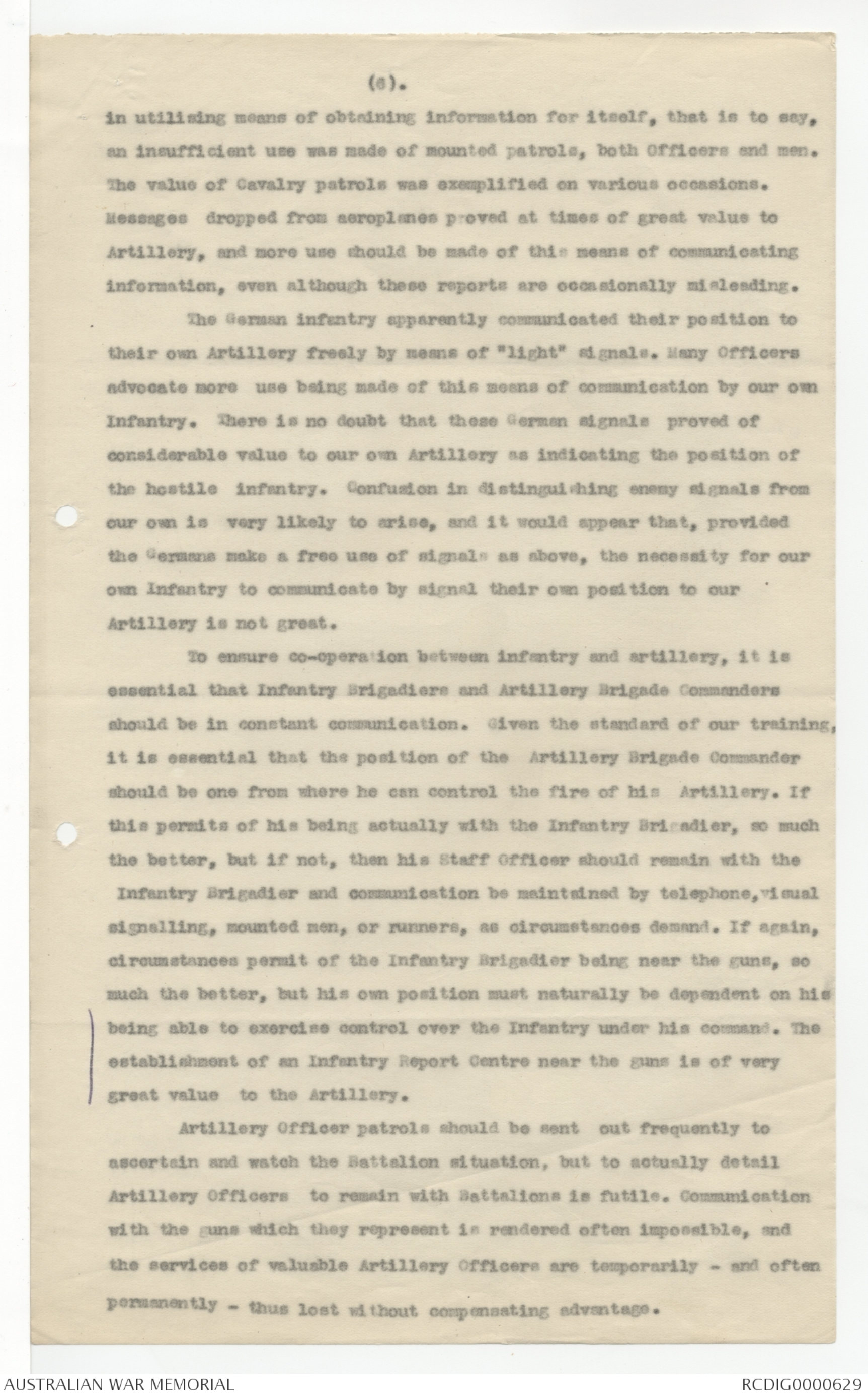
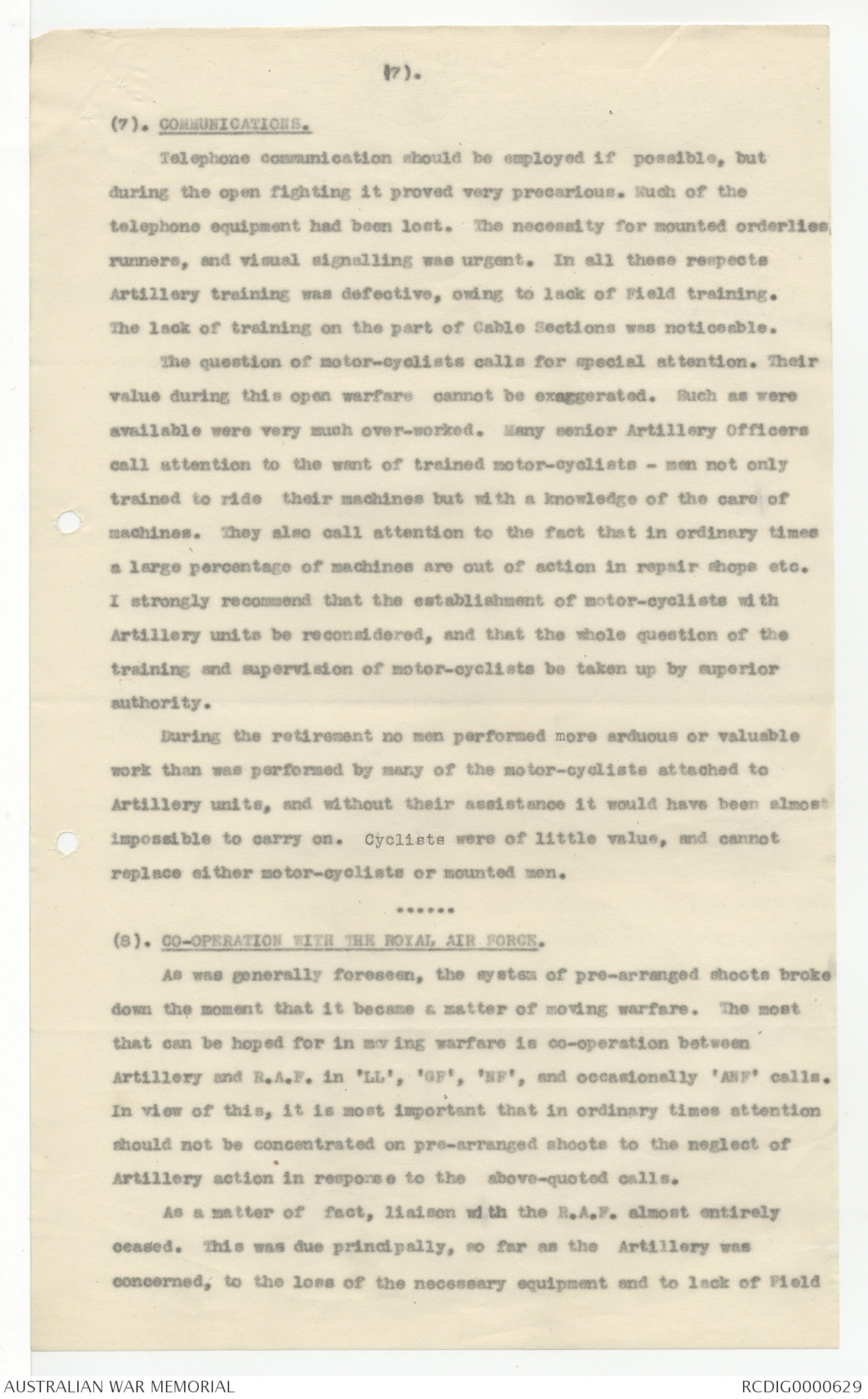
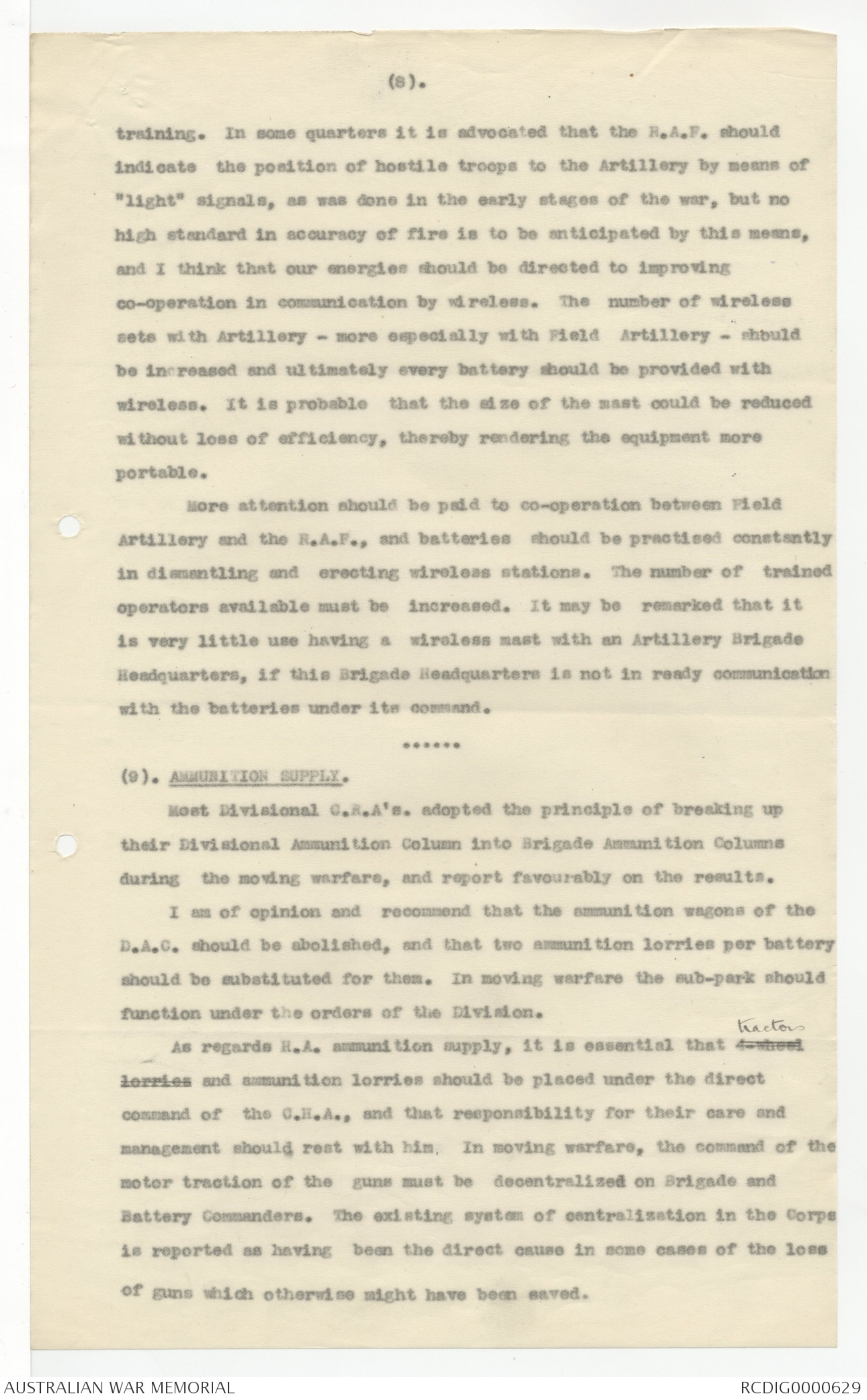
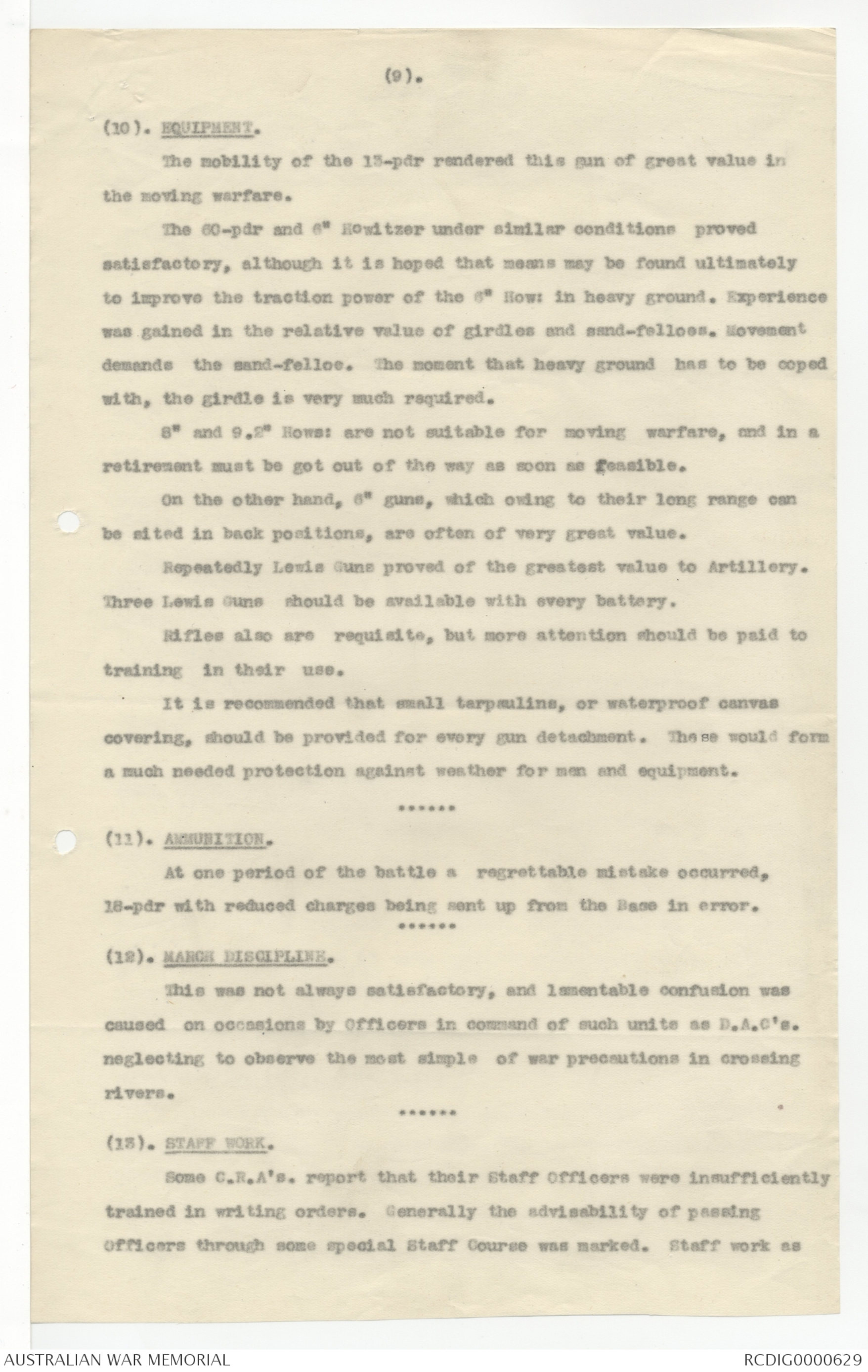
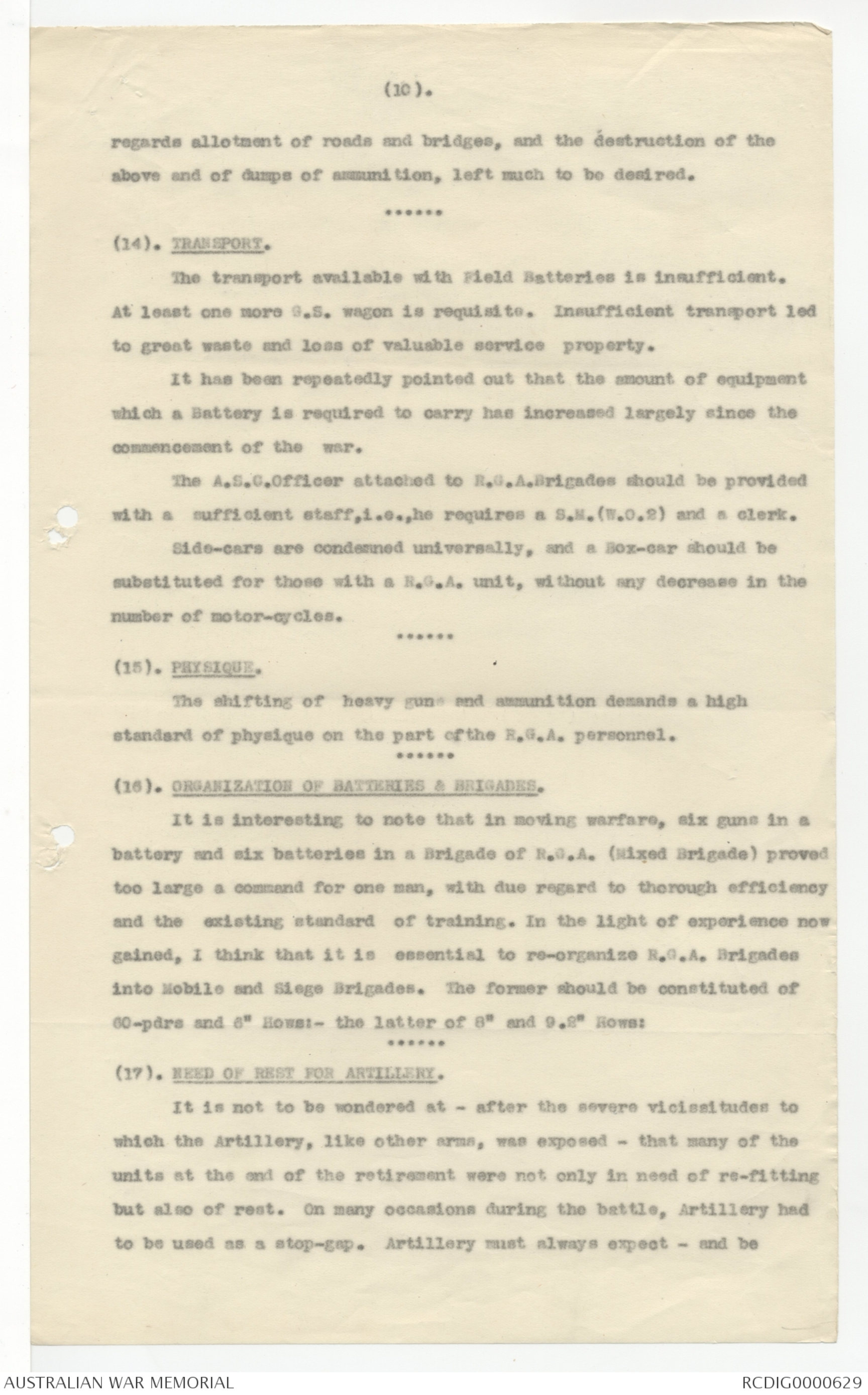
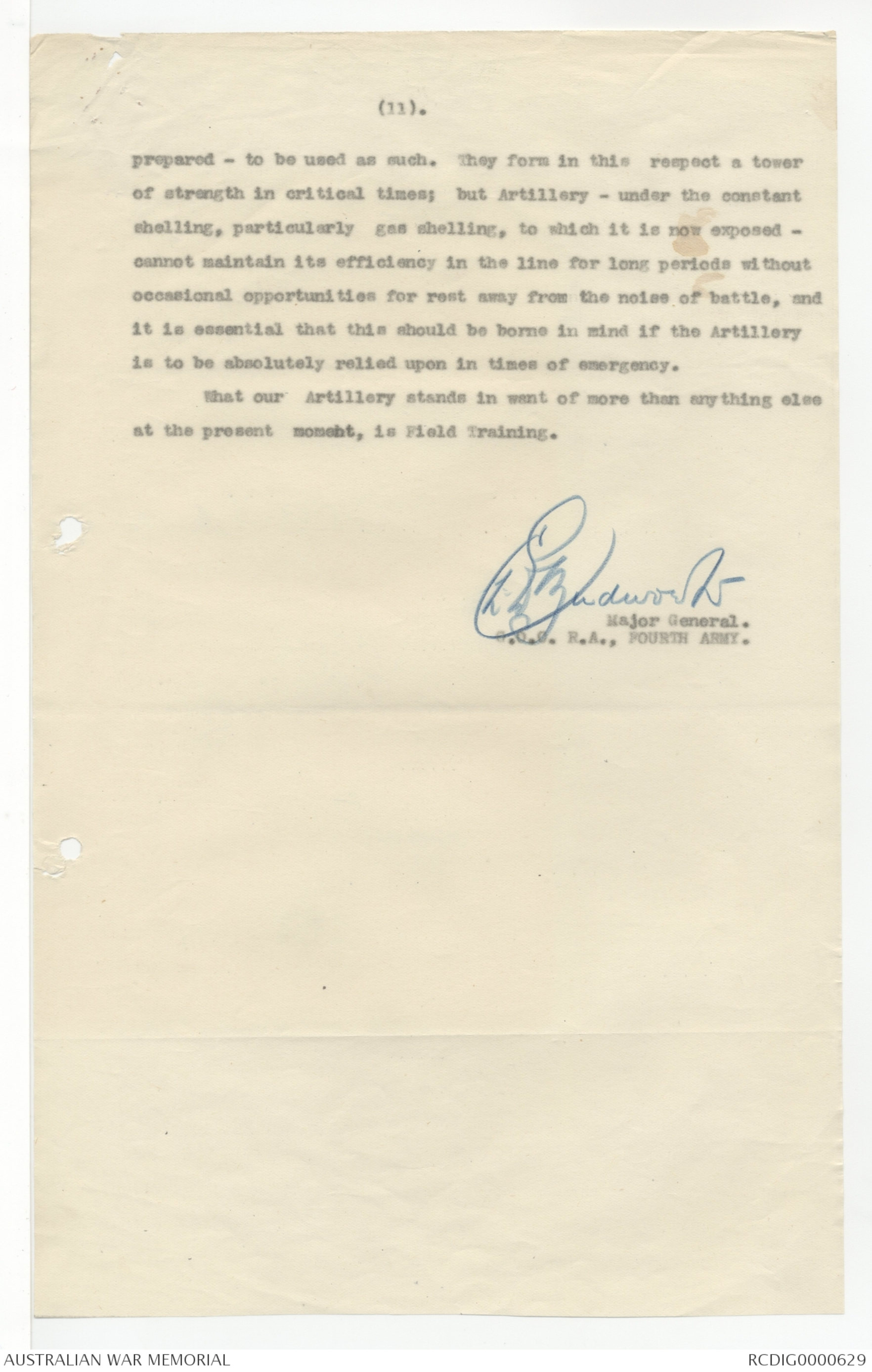
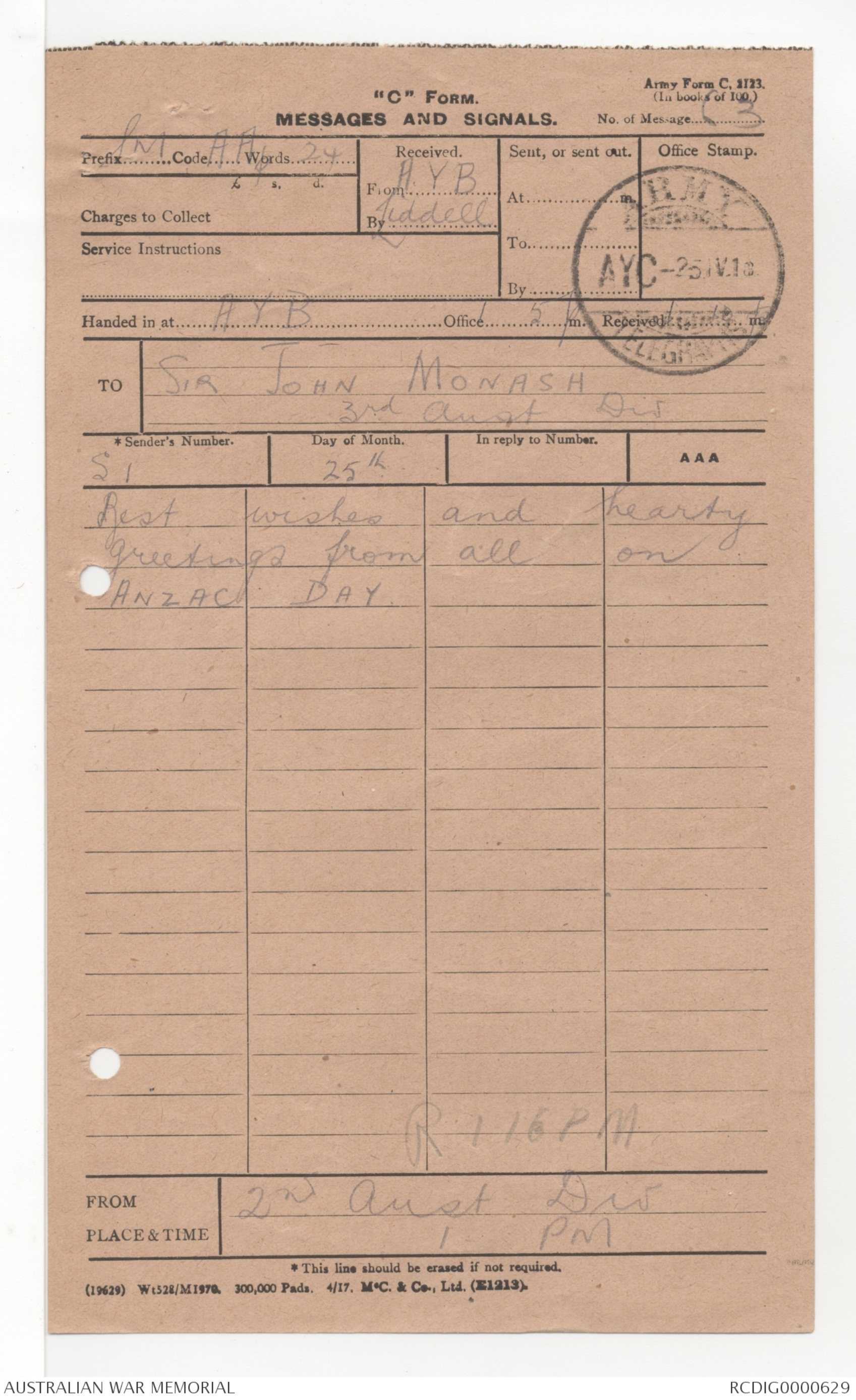
(3).
must be left to shift themselves. To allow time for these posts
to retire on the front line is to allow time for the assaulting troops
to advance immune from our Artillery fire. Perhaps the principal
lesson is the need for "elasticity" in barrage. This must be obtained
by a well thought out plan of O.P's in depth, good communications, and
training of junior Artillery officers in initiative. Finally, if one
cannot see, one must try to hear, and the S.O.S. "light" signal should
be supplemented by a "sound" signal for use in foggy weather.
(c). COUNTER PREPARATION. In drawing up a counter-preparation
scheme, the uncertainty of the duration of the enemy's immediate
preparations for attack, prior to the delivery of the assault, always
constitutes a difficulty. The constant dread exists that the duration
of this period may result in a very large expenditure of ammunition,
leaving insufficient to deal with the later stages. As a result our
counter-preparation schemes tend often to an immediate development of
fire, which loses its intensity as time goes on. What we require to
aim at is naturally the reverse, i.e., a development of fire, growing
rather than diminishing in intensity. When the enemy's intentions to
assume the offensive first become evident, our efforts should be
directed specially to vgigorous counter-battery work and interference
with his initial arrangements.
When it appears that the enemy has commenced his immediate
preparations for an attack, harassing fire - which should consist
principally of fire directed against his artillery, communications, and
important traffic centres - should be developed. As soon as circumstances
lead to the conclusion that the enemy's troops are moving up in
preparation for the assault, annihilating fire should be resorted to.
The entire strength of the Artillery should be used for the purpose.
The hostile front system should be swept by bursts of fire from
Field and Heavy Guns, and from Field and Medium Howitzers.
This searching fire should be applied far enough back to include
heavy machine gun positions, and localities of assembly from which the
enemy is working his way forward into the front line, and near enough up
to include light machine guns, which may have been pushed forward.
(4).
The above may be taken to involve normally searching fire to a
depth of 2,000 yards from the hostile front line.
The fire of 8" and 9.2" Howitzers should be maintained on
important localities and traffic centres.
Long range guns should continue to shell distant communications,
balloons, etc.
The responsibility for ordering harassing counter-preparation or
annihilating counter-preparation should rest with the Division, who
should report action taken immediately to the Corps. Annihilating
counter-preparation must be heavy, and demands the expenditure of much
ammunition. It should not be resorted to, therefore, unless the
situation really demands it, and should be maintained for short periods
only. After an interval, it should be repeated if necessary or harassing
fire reverted to.
(d). DEFENCE IN DEPTH.
There is no more salvation in defence in depth then there is in
a defensive barrage. Adequacy in artillery defence cannot be arranged
without adequacy in guns for the purpose. If guns are few, obviously
there can be no strong artillery line of defence where such should
exist. If the Artillery is strong, it is easy to arrange for forward
guns and artillery in tiers of defence. If Artillery is weak, then it
is best to employ forward guns, and build up as strong a line of defence
as possible in rear.
To go beyond this and to organize the Artillery defence in depth
merely for the sake of being in depth only leads to being weak
everywhere. Whether weak or strong it will almost al-ways be advisable
to retain sone units mobile.
(e). FORWARD GUNS.
Although circumstances rendered forward guns in some cases
unavailing, enough instances occurred to prove their great value as a
general principle in defence. Guns pushed forward for anti-tank defence
must be considered as equally available for defence against infantry,
and sited accordingly.
(f). Immediately before the German attack became imminent, the
positions of many of our batteries were changed. This policy was
(5)
justified, and saved several batteries from destruction or neutralization
of fire.
(5). FIELD TRAINING & OPEN WARFARE
Our Artillery is not trained for open warfare. No orders or issue
of instructions will remedy matters. Field training is what is
required, and the instructions already issued on the subject suffice.
Our Artillery lacks power of manoeuvre. The relative superiority of
Horse Artillery, due to more facilities for Field training, is
generally reported upon as noticeable. Fortunately for us, the Germans
appear to have been sadly lacking in enterprise or Field Training. Had
they been provided with Cavalry, supported by efficient Horse Artillery,
we should have suffered much more severely.
The following points are cited as special examples of defects in
training: -
(a). Batteries lacking in training, in mounted drill, manoeuvre,
and use of ground.
(b). Batteries untrained in retirement and covering fire.
(c). Batteries untrained in limbering up and coming into action
with due rapidity.
(d). Position of wagon lines selected badly.
(e). Batteries indifferently trained in the use of open sights.
The result of this indifferent Field Training was that, although the
Artillery record may be described as one long record of gallantry, in
many cases Units were inclined - through ignorance and lack of
confidence in their manoeuvre powers - to withdraw from positions which
might have been held much longer than was actually the case, with
destructive effect to the Germans. Generally speaking, senior Artillery
Officers were quick to grasp the situation, and junior Officers and
other ranks began rapidly to assimilate their action to the novel
conditions of warfare.
(a). INFORMATION & LIAISON WITH INFANTRY
The C.R.A. must maintain close touch with the Division under whose
orders he is working,otherwise the Artillery is starved of information.
Owing to lack of Field training, the Artillery was somewhat backward
(6).
in utilising means of obtaining information for itself, that is to say,
an insufficient use was made of mounted patrols, both Officers and men.
The value of Cavalry patrols was exemplified on various occasions.
Messages dropped from aeroplanes proved at times of great value to
Artillery, and more use should be made of this means of communicating
information, even although these reports are occasionally misleading.
The German infantry apparently communicated their position to
their own Artillery freely by means of "light" signals. Many Officers
advocate more use being made of this means of communication by our own
Infantry. There is no doubt that these German signals proved of
considerable value to our own Artillery as indicating the position of
the hostile infantry. Confusion in distinguishing enemy signals from
our own is very likely to arise, and it would appear that, provided
the Germans make a free use of signals as above, the necessity for our
own Infantry to communicate by signal their own position to our
Artillery is not great.
To ensure co-operation between infantry and artillery, it is
essential that Infantry Brigadiers and Artillery Brigade Commanders
should be in constant communications. Given the standard of our training,
it is essential that the position of the Artillery Brigade Commander
should be one from where he can control the fire of his Artillery. If
this permits of his being actually with the Infantry brigadier, so much
the better, but if not, then his Staff Officer should remain with the
Infantry Brigadier and communication be maintained by telephone, visual
signalling, mounted men, or runners, as circumstances demand. If again,
circumstances permit of the Infantry Brigadier being near the guns, so
much the better, but his own position must naturally be dependent on his
being able to exercise control over the Infantry under his command. The
establishment of on Infantry Report Centre near the guns is of very
great value to the Artillery.
Artillery Officer patrols should be sent out frequently to
ascertain and watch the Battalion situation, but to actually detail
Artillery Officers to remain with Battalions is futile. Communication
with the guns which they represent is rendered often impossible, and
the services of valuable Artillery Officers are temporarily - and often
permanently - thus lost without compensating advantage.
|7).
(7). COMMUNICATIONS,
Telephone communication should be employed if possible, but
during the open fighting it proved very precarious. Much of the
telephone equipment had been lost. The necessity for mounted orderlies
runners, and visual signalling was urgent. In all these respects
Artillery training was defective, owing to lack of Field training.
The lack of training on the part of Cable Sections was noticeable.
The question of motor-cyclists calls for special attention. Their
value during this open warfare cannot be exaggerated. Such as were
available were very much over-worked. Many senior Artillery Officers
call attention to the want of trained motor-cyclists - men not only
trained to ride their machines but with a knowledge of the care of
machines. They also call attention to the fact that in ordinary times
a large percentage of machines are out of action in repair shops etc.
I strongly recommend that the establishment of motor-cyclists with
Artillery units be reconsidered, and that the whole question of the
training and supervision of motor-cyclists be taken up by superior
authority.
During the retirement no men performed more arduous or valuable
work than was performed by many of the motor-cyclists attached to
Artillery units, and without their assistance it would have been almost
impossible to carry on. Cyclists were of little value, and cannot
replace either motor-cyclists or mounted men.
******
(8). CO-OPERATION WITH THE ROYAL AIR FORCE.
As was generally foreseen, the system of pre-arranged shoots broke
down the moment that it became a matter of moving warfare. The most
that can be hoped for in moving warfare is co-operation between
Artillery and R.A.F. in 'LL', 'GF', NF', and occasionally 'ANF' calls.
In view of this, it is most important that in ordinary times attention
should not be concentrated on pre-arranged shoots to the neglect of
Artillery action in response to the above-quoted calls.
As a matter of fact, liaison with the R.A.F. almost entirely
ceased. This was due principally, so far as the Artillery was
concerned, to the loss of the necessary equipment and to lack of Field
(8).
training. In some quarters it is advocated that the R.A.F. should
indicate the position of hostile troops to the Artillery by means of
"light" signals, as was done in the early stages of the war, but no
high standard in accuracy of fire is to be anticipated by this means,
and I think that our energies should be directed to improving
co-operation in communication by wireless. The number of wireless
sets with Artillery - more especially with Field Artillery - should
be increased and ultimately every battery should be provided with
wireless. It is probable that the size of the mast could be reduced
without loss of efficiency, thereby rendering the equipment more
portable.
More attention should be paid to co-operation between Field
Artillery and the R.A.F., and batteries should be practised constantly
in dismantling and erecting wireless stations. The number of trained
operators available must be increased. It may be remarked that it
is very little use having a wireless mast with an Artillery Brigade
Headquarters, if this Brigade Headquarters is not in ready communication
with the batteries under its command.
(9). AMMUNITION SUPPLY.
Most Divisional C.R.A's. adopted the principle of breaking up
their Divisional Ammunition Column into Brigade Ammunition Columns
during the moving warfare, and report favourably on the results.
I am of opinion and recommend that the ammunition wagons of the
D.A.C. should be abolished, and that two ammunition lorries per battery
should be substituted for them. In moving warfare the sub-park should
function under the orders of the Division.
As regards H.A. ammunition supply, it is essential that 4-wheel tractorslorries and ammunition lorries should be placed under the direct
command of the C.H.A., and that responsibility for their care and
management should rest with him. In moving warfare, the command of the
motor traction of the guns must be decentralized on Brigade and
Battery Commanders. The existing system of centralization in the Corps
is reported as having been the direct cause in some cases of the loss
of guns which otherwise might have been saved.
(9).
(10). EQUIPMENT
The mobility of the 13-pdr rendered this gun of great value in
the moving warfare.
The 60-pdr and 6" Howitzer under similar conditions proved
satisfactory, although it is hoped that means may be found ultimately
to improve the traction power of the 6" How: in heavy ground. Experience
was gained in the relative value of girdles and sand-felloes. Movement
demands the sand-felloe. The moment that heavy ground has to be coped
with, the girdle is very much required.
8" and 9.2" Hows: are not suitable for moving warfare, and in a
retirement must be got out of the way as soon as feasible.
On the other hand, 6" guns, which owing to their long range can
be sited in back positions, are often of very great value.
Repeatedly Lewis Guns proved of the greatest value to Artillery.
Three Lewis Guns should be available with every battery.
Rifles also are requisite, but more attention should be paid to
training in their use.
It is recommended that small tarpaulins, or waterproof canvas
covering, should be provided for every gun detachment. These would form
a much needed protection against weather for men and equipment.
(11). AMMUNITION.
At one period of the battle a regrettable mistake occurred,
18-pdr with reduced charges being sent up from the Base in error.
(12). MARCH DISCIPLINE.
This was not always satisfactory, and lamentable confusion was
caused on occasions by Officers in command of such units as D.A.C's.
neglecting to observe the most simple of war precautions in crossing
rivers.
(13). STAFF WORK.
Some C.R .A's. report that their Staff Officers were insufficiently
trained in writing orders. Generally the advisability of passing
officers through come special Staff Course was marked. Staff work as
(10).
regards allotment of roads and bridges, and the destruction of the
above and of dumps of ammunition, left much to be desired.
(14). TRANSPORT.
The transport available with Field Batteries is insufficient.
At least one more G.S. wagon is requisite. Insufficient transport led
to great waste and loss of valuable service property.
It has been repeatedly pointed out that the amount of equipment
which a Battery is required to carry has increased largely since the
commencement of the war.
The A.S.C. Officer attached to R.G.A. Brigades should be provided
with a sufficient staff, i.e., he requires a S.M. (W.O.2) and a clerk.
Side-cars are condemned universally, and a Box-car should be
substituted for those with a R.G.A. unit, without any decrease in the
number of motor-cycles.
(15). PHYSIQUE.
The shifting of heavy guns and ammunition demands a high
standard of physique on the part of the R.G.A. personnel.
(16). ORGANIZATION OF BATTERIES & BRIGADES.
It is interesting to note that in moving warfare, six guns in a
battery and six batteries in a Brigade of R.G.A. (Mixed Brigade) proved
too large a command for one man, with due regard to thorough efficiency
and the existing standard of training. In the light of experience now
gained, I think that it is essential to re-organize R.G.A. Brigades
into Mobile and Siege Brigades. The former should be constituted of
60-pdrs and 6" Hows:- the latter of 8" and 9.2" Hows:
(17). NEED OF REST FOR ARTILLERY.
It is not to be wondered at - after the severe vicissitudes to
which the Artillery, like other arms, was exposed - that many of the
units at the end of the retirement were not only in need of re-fitting
but also of rest. On many occasions during the battle, Artillery had
to be used as a stop-gap. Artillery must always expect - and be
(11).
prepared - to be used as such. They form in this respect a tower
of strength in critical times; but Artillery - under the constant
shelling, particularly gas shelling, to which it is now exposed -
cannot maintain its efficiency in the line for long periods without
occasional opportunities for rest away from the noise of battle, and
it is essential that this should be borne in mind if the Artillery
is to be absolutely relied upon in times of emergency.
What our Artillery stands in want of more than anything else
at the present moment, is Field Training.
WR Birdwood
Major General.
G.O.C. R.A., FOURTH ARMY
"C" Form. Army Form C, 2123
(In book of 100)
MESSACES AND SIGNALS. No of Messages 63
Prefix SM Code AA Words 24
Received
From H Y B
By Liddell
Sent, or sent out.
At m.
To
By
Office Stamp
[-ARMY
AYC-25IV.18
Telegraphs*]
£. s. d.
Charges to Collect
Handed in at AYB Office 1 5 pm. Received
To Sir John Monash
3rd Aust Div
*Sender's Number Day of Month In reply to Number AAA
S I 25th
Best wishes and hearty
greetings from all on
ANZAC DAY
R 1 16PM
FROM 2nd Aust Div
PLACE & TIME 1 PM
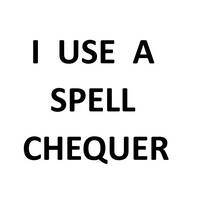 Not Yet Replaced By AI
Not Yet Replaced By AIThis transcription item is now locked to you for editing. To release the lock either Save your changes or Cancel.
This lock will be automatically released after 60 minutes of inactivity.